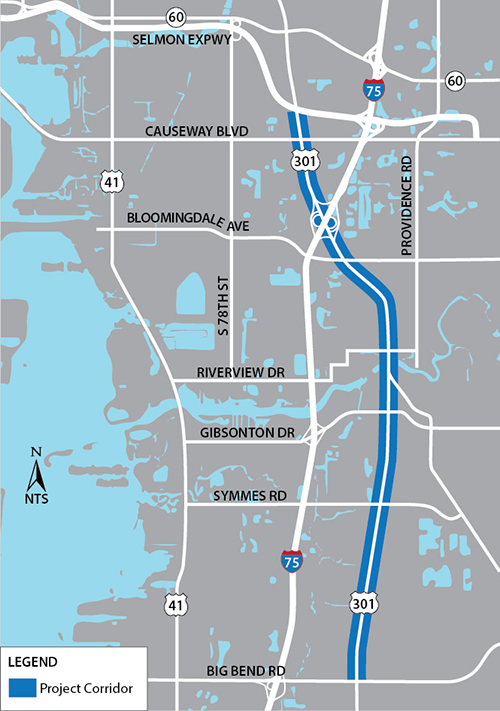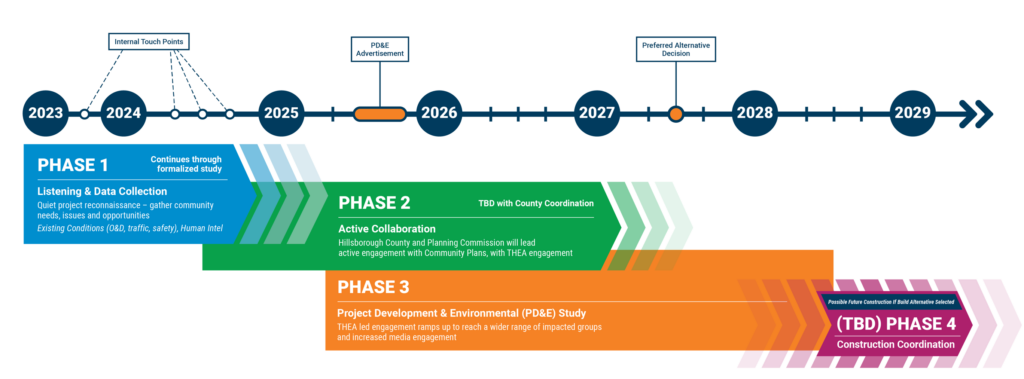Significant population growth in Eastern and Southern Hillsborough County has substantially burdened the existing roadway infrastructure. In response to this challenge, the Hillsborough County Board of County Commissioners voted unanimously in June 2023 for the Tampa Hillsborough Expressway Authority (THEA) to conduct a Project Development and Environment (PD&E) study along US 301. This comprehensive study aims to assess the requirements, associated costs, and potential impacts of capacity improvements to US 301, which spans approximately 10 miles from the Selmon Expressway to Big Bend Road.
THEA is taking proactive steps to work with agencies and stakeholders to listen to the community in advance of initiating the PD&E Study, collect data, and further understand the community needs to inform the study process.
Q: What is the project THEA is considering, and why now?
A: Significant population growth in eastern and southern Hillsborough County has substantially burdened the existing roadway infrastructure. In response to this challenge, the Hillsborough County Board of County Commissioners voted unanimously in June 2023 for THEA to conduct a US 301 Project Development and Environment Study (PD&E) to examine ways to ease traffic congestion in the US 301 corridor.
Q: What is a Project Development and Environment (PD&E) Study?
A: A PD&E study is a process developed by the Florida Department of Transportation to determine social, economic, natural, and physical environmental impacts associated with a proposed transportation improvement project. The process follows procedures set forth in federal and state laws and regulations. A PD&E Study includes a public hearing to notify of potential alternatives and benefits and needs to be completed before construction plans can be developed and scheduled.
Q: What is the status of the project now?
A: The project is in the pre-PD&E stage. Pre-planning analysis is underway, but no plans have been developed. Right now, THEA is most interested in gathering feedback from residents and businesses along the US 301 corridor, to ascertain needs, issues, and concerns. Information received during this “listening stage” will help determine how THEA should proceed. Once the PD&E study begins, the public will be provided additional opportunities to engage and provide feedback.
Q: What will the THEA US 301 PD&E Study examine?
A: When the THEA US 301 PD&E Study begins, THEA will examine the possibility of adding additional toll lanes in the corridor, connecting the Selmon Expressway on the north and Big Bend Road on the south, a distance of about 10 miles. The project could include elevated toll lanes above the US 301 corridor, similar to the Selmon West Extension THEA recently developed over Gandy Boulevard.
Q: What will be the objective of the THEA US 301 PD&E Study?
A: The primary focus will be to identify needs, evaluate alternatives, and develop recommendations to alleviate congestion on US 301, I-75, and local arterial roads, along with several US 301 intersections. This comprehensive study aims to assess the requirements, associated costs, and potential impacts of creating an elevated corridor within the median of US 301.
Q: Do we know how this project will benefit the community?
A: Part of what THEA will do in the PD&E Study is learn about the benefits of building a toll road extension. Early assumptions include significant community benefits with potential time savings to commuters, reduced wait times at intersections along US 301, safety benefits, evacuation and resiliency, and livability. The PD&E study will evaluate and quantify the benefits that a toll road extension could provide.
Q: How soon can this project be completed?
A: A projected opening date is years away, with many questions to be answered, approvals to be considered, and design plans developed before construction could begin. The next step is to start the PD&E study, which will address many initial considerations.
Q: How much would this cost and how would we pay for it?
A: The capital cost and operating expenses have yet to be determined. Preliminary budget estimates, including funding sources, will be developed during the PD&E Study.
Q: Are THEA road projects toll roads?
A: Yes, THEA is a tolling authority, established by the Florida Legislature in 1963 as a transportation option to bring roadway infrastructure projects online sooner by issuing bonds and using toll revenue dollars. All THEA toll revenues stay here in Tampa and Hillsborough County and are invested back into the community as part of a transportation system that provides regional connectivity to residents and visitors.
Q: How can I provide feedback and stay informed?
A: The US 301 PD&E project website is a great resource. Questions and comments can be submitted there. The website will also include a link to public surveys when available and public meetings when scheduled.


